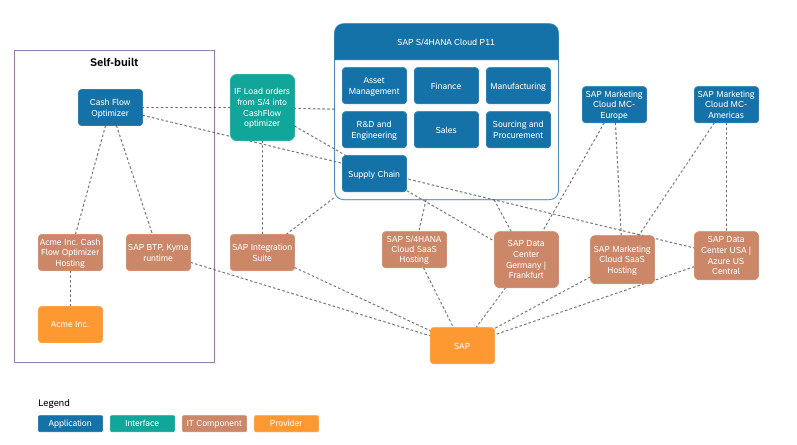Modeling SAP Cloud Solutions
Understand the business and technical perspectives of modeling SAP Cloud Solutions and learn how to model them in SAP LeanIX.
SAP Cloud Solutions Modeling Perspectives
SAP's cloud portfolio, mainly offered as Software-as-a-Service (SaaS), aligns with the evolving architecture of ERP landscapes. Offered through the SAP Business Technology Platform (BTP), it provides a robust platform and integration for various business needs. Key examples of SAP cloud solutions include:
- At the core are Cloud ERP solutions: SAP S/4HANA Cloud Private Edition and SAP S/4HANA Cloud Public Edition.
- A portfolio of integrated SAP and ecosystem applications: HCM, Spend, CRM, Business Transformation, SAP Ariba, SAP Concur, SAP SuccessFactors, SAP Signavio, and SAP LeanIX.
- Foundational technology for integration and extension: SAP Business Technology Platform (SAP BTP).
SAP Cloud Solutions Modeling Best Practices and Guidelines
- SAP cloud solutions and all important instances are modeled as an application. Name the application in a way a business user would call it, e.g., SAP S/4HANA Private Cloud, SAP Ariba Sourcing, SAP Ariba Procurement, SAP SuccessFactors HXM Suite, SAP Signavio Process Intelligence, Signavio Process Manager, SAP LeanIX would be level-1 applications and the modules such as Asset Management, Finance, Manufacturing would be level-2 applications.
- You can leverage SAP LeanIX SaaS Discovery to detect some of the SaaS applications and also identify multiple instances of them.
- To add more context and accuracy to the model, two IT components should be associated with these applications:
- One for representing the service itself.
- One for representing the region of the data center where the service is hosted.
- Optional: The platform fact sheet can facilitate communication with business stakeholders using commonly understood terminology. It makes sense if your organization has different platforms and if the concept is typically understood by your business stakeholders. For more details, refer to Platform Modeling Guidelines. If you use the platform fact sheet in the context of your SAP ERP transformation, you might want to create a platform fact sheet “Old ERP” and a Fact Sheet “New ERP - S/4HANA” (for other organizations, it could be “OneERP”).
- Optional: If you want to map interfaces between your SAP systems to SAP LeanIX, use the interface fact sheet type. This is in particular critical for S/4HANA transformation use cases where you need to understand your organization's integration architecture.
Choose Clear Naming for your Applications
When modeling SAP cloud solutions in SAP LeanIX, it's important to assign meaningful names for the applications to convey a clear business context.

Modeling Example for SAP Cloud Solutions
Handling Multiple Instances of SAP Cloud Solutions
Organizations often maintain multiple instances of SAP cloud solutions for different geographies and organizational contexts. It is recommended to capture these as separate applications in SAP LeanIX to reflect variations in ownership and business context. However, when dealing with different stages, such as development (Dev), quality assurance (QA), and production (Prod), it's best to document only the production (Prod) instances in SAP LeanIX to ensure more efficient application management and monitoring.
Updated 10 months ago
